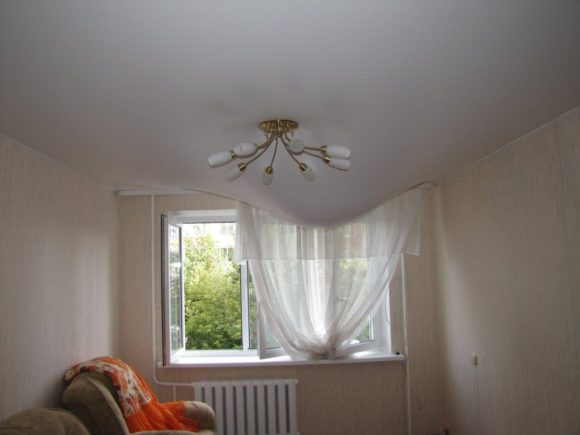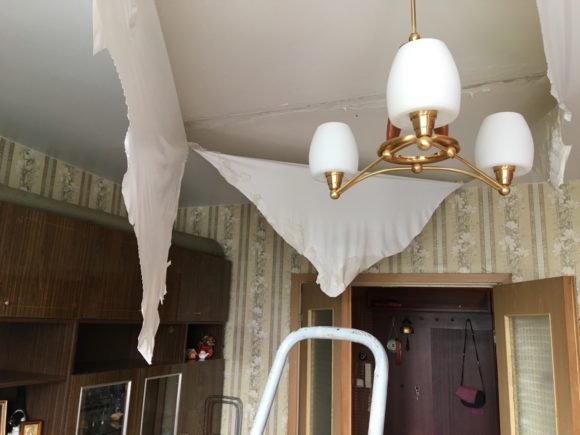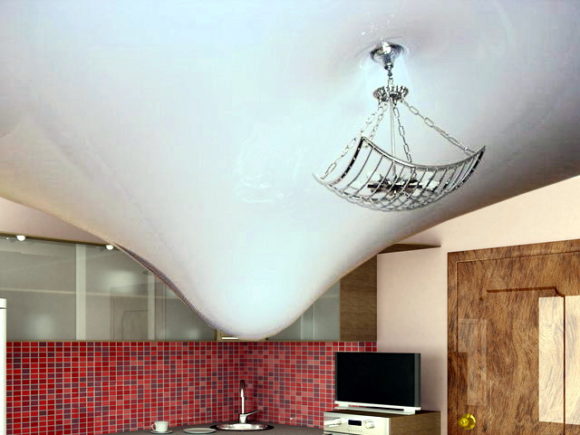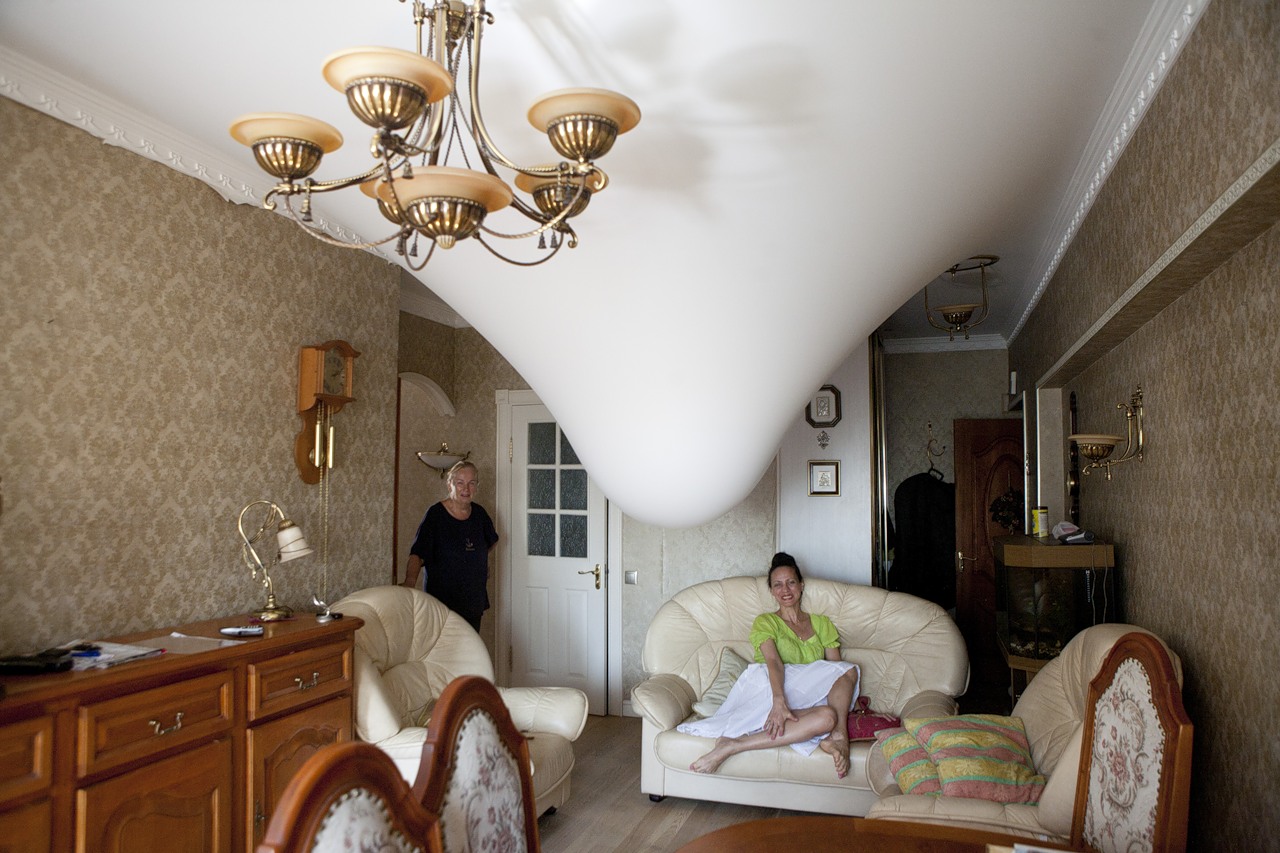Sometimes in an apartment or a private house it can flood the ceiling with water. In a private house, the roof may leak and during the rain the water will reach the ceiling, and in the apartment neighbors will flood from above or breakthrough of communications on the roof will occur. The list of what to do if the suspended ceiling is flooded is already verified and clear. When they flood the ceiling, eliminating the consequences is not so difficult. PVC film will prevent damage to furniture by retaining water.
Content
How pvc ceiling can protect against flood
Polyvinyl chloride, abbreviated as PVC, which is the material from which the ceiling fabric is made, has high elasticity and strength. The thickness of the PVC film is from 0.16 to 0.35 mm, but it is able to “hold” up to 100 kg per 1 cm2. This property protects walls, flooring, household appliances and furniture from the negative effects of liquids in case of flooding the ceiling.
Liquid often collects at 1 point due to the fact that under its own weight, water provokes stretching of the ceiling sheet and it sags. The resulting funnel collects all the moisture completely - drops of water flow down into it along the formed slope. After it is enough to drain the liquid, dry the PVC film and eliminate the defects that may occur due to prolonged stretching of the canvas at one point, and the ceiling will return to its original form.
The root causes of flooding and their impact on mitigation
Depending on the cause of the flooding of the stretch ceiling, measures are identified to eliminate the effects of the flood. Some of the causes of the flood do little harm to the PVC film of the stretch ceiling, and some of them lead to the fact that a complete replacement of the canvas is necessary. There are a number of the most common factors that lead to flooding in apartment buildings:
- failure of the washing machine;
- storm runoff damage;
- breakthroughs of the sewer system;
- breakdowns of pipes of the heat supply system;
- breakthroughs of hot and cold water pipes.
Liquid can also get on the ceiling in the private sector due to gaps in the roof deck.
It is not always possible to deal with the consequences of the flood with minimal losses - some types of fluid render the stretch fabric unusable, for example, sewage. Considering the causes of flooding of the ceiling, it must be taken into account that hot water causes the PVC film to spoil without any chance of restoration. Cold water has a less negative effect on the tension web. An important point is the purity of the liquid - minimal damage to the stretch ceiling will be caused by cold cold tap water, but soapy liquid from washing machines will cause significant damage to the PVC cloth.

What to do when flooded
It is recommended that even before the installation of the stretch ceiling fabric, develop an action plan in case of a "flood" and carefully review the instructions - how to behave in such a situation. This is a necessity, since with the development of such a scenario in a hurry you can skip something important and spoil the PVC film. The sequence of actions in case of flooding is as follows:
- Power outage in the housing - you must turn off the machine or unscrew the meter plugs.When there is a protective relay that will automatically cut off in the event of a short circuit, but act correctly in advance.
- To eliminate the circumstance that led to the accumulation of water - to call neighbors when they are not in place - to shut off water to the apartment building. In the case of the private sector, go up to the attic and place a basin / bucket to collect the liquid.
- Call the emergency crew of the water utility if it is not possible to shut off water to the apartment building or to contact the neighbors.
- When the water canal cannot block the water due to any circumstances, it is necessary to call the police (district) - in his presence, the emergency team has the right to open the door of the apartment above and block the water in it.
It is forbidden to open the door to the apartment of neighbors without their presence in case of flooding the ceiling.
After eliminating the source of water, it is necessary to begin analysis and elimination of the consequences. To do this, drain the liquid that has collected under the ceiling, dry the ceiling slabs. After the floor slabs have dried, the ceiling PVC-cloth is again fixed on a baguette. There are 2 options for the correct action, if necessary, to drain the water.
When a chandelier and / or lights are integrated in the canvas
The first option is used when there are built-in lighting devices in the stretch ceiling - lamps, a chandelier. It is necessary to remove the lighting device closest to the funnel with water, and the liquid is carefully shifted (rolled) with your hands to the thermal ring. Through it, the liquid is poured into a basin or other container. When there is too much fluid and not enough bucket volume, apply a hose.
One end is led to the bottom of the funnel through a thermal ring, and through the other, liquid is drained. In order for the water to begin to drain, it is necessary to discharge air at the second end of the hose. To do this, it is possible to use a medical syringe or gently (so that dirty water does not get into the mouth, and then into the lungs or esophagus), draw air into yourself, leaning the opening to your lips.

After removing the liquid, the ceiling is thoroughly dried. In the area where a funnel of water has formed, the PVC fabric is stretched and takes on an unattractive appearance. To eliminate such a defect, the film in this zone is dried by force - it is heated with a hair dryer until it returns to its original tension. After restoration of appearance, the removed lighting device is mounted in place.
When the film is continuous
The second option for draining water from the ceiling is suitable exclusively for those versions of stretch linens that do not have built-in lighting devices. When there are no thermal rings, it is necessary to partially remove one of the sides of the stretch fabric from the baguette on which the PVC film is attached. The further process has little differences from the first version of the drain, but there are some features. The algorithm of actions in the case of a continuous ceiling tension web is as follows:
- With a spatula (self-tapping screw), the harpoon of the canvas is removed from the baguette - as close to the funnel with liquid as possible. It is better when the distance to the funnel from the baguette is 10-15 cm. Before starting the manipulation, it is necessary to warm the stretched place of the film with a hairdryer - so that the stretch fabric becomes elastic.
- A hose is introduced through the hole made, sent to the center of the funnel with water and the liquid is drained.
- After draining, the ceilings and the canvas are allowed to dry, and at the place of attachment to the baguette, the film is heated with a hairdryer and refilled.
When the PVC fabric is continuous and has no built-in lighting devices, it is strictly forbidden to pierce it to drain the liquid!
What tools are needed to drain the fluid?
In order to drain the liquid from the web of the stretch fabric and restore its original appearance, it is necessary to prepare in advance all the tools and consumables that may be needed during the procedure. It is advisable that 2 people participate in the process of draining the water - this will simplify the task.Regardless of whether there are built-in lighting elements or a continuous canvas, the following will be necessary at hand:
- set of screwdrivers;
- pliers;
- self-tapping screws;
- hair dryer;
- putty knife.
Screwdrivers and pliers are needed during the removal of built-in fixtures. They will also be necessary for screwing screws into the edge of the film in the harpoon area, after removing the finishing panel in the case of a solid canvas. Pull with a pair of pliers for a self-tapping screw and pull out the edge of the film from the baguette by 40-60 cm. The PVC film is heated with a hairdryer so that it is pulled in the area of the funnel. The spatula is necessary so that after the completion of the fluid drain, refill the ceiling PVC-fabric in place and fix it in its original position.
Advice
When there is a lot of liquid accumulated on the canvas after flooding, and the water has stood for a long time, it must be borne in mind that the film will subsequently be inhomogeneous. As a result, it will be necessary to warm up the PVC film in all areas where it has lost smoothness until the canvas regains smoothness and uniformity. The hair dryer should be powerful - from 2000 watts.
In the kitchen, bathroom and toilet, it is not recommended to stretch fabric ceiling linens, as they are able to absorb and retain surrounding odors. Fabrics do not hold moisture, after the first flooding come into disrepair. Therefore, it is better to install stretch ceilings made of PVC film in all rooms where strong odors are present and there is a high probability of flooding.

During the installation of the ceiling tension fabric, it is recommended that the masters specify all the circumstances of its fixation. Particular attention must be paid to the use of sealant during installation. A sealant is a composition that will prevent liquid from entering the walls if the stretch ceiling has been flooded. Its use is mandatory, since without sealant damage to property and the decoration of the premises during a flood increases many times.
The complexity of mounting the tension web with built-in lighting devices is greater, the price, respectively, is higher. But, in case of flooding, it is much easier to discharge the water.
Common mistakes
When the stretch ceiling was flooded for the first time, they often make the same mistakes. The most common of these is an error in estimating the volume of liquid that has accumulated in the funnel. The first impression reports that there is little water in the funnel - not more than 10-20 liters. But, after the beginning of the discharge, it becomes clear that the liquid is at least 2-3 times more. As a result, panic begins, unnecessary fuss and searches for auxiliary containers for drained water. To prevent such a development of events, it is necessary to prepare more tanks in advance - instead of 2 buckets, take 4-5 pieces.
Sometimes, if desired, with your own hands, without professional help, to drain the liquid from the ceiling tension web, they decide to puncture the film in the funnel area with a needle. But, in the case of PVC film under severe tension, the miniature hole is rapidly increasing. The result - a gap on the PVC fabric, which cannot be repaired, and damage to the finish, furniture and appliances with a large volume of liquid spilled simultaneously.
A common mistake when flooding a ceiling stretch web is the desire to smooth out the crater on the PVC film. This action is incorrect, as it leads to the distribution of accumulated liquid over the entire area of the ceiling. Subsequently, high-quality drying of the film will be difficult. If you do not dry the stretch fabric, then it will bloom and become a source of an unpleasant odor of dampness in the room.
The best option, when there are no specific skills and self-confidence, is the challenge of specialists in working with suspended ceilings. With the least damage to the PVC film, they are capable of eliminating the effects of the flood in a short time period and accurately restore the original appearance of the stretch ceiling.
Sometimes contacting a company working with suspended ceilings is the only right option. It is necessary to call the masters when the canvas was flooded due to a breakthrough in the heating system, hot water riser, and sewer system.
The cost of draining water from a stretch ceiling by craftsmen depends on the region. The average price for emergency liquid removal is about 2000-3000 rubles. At the same time, experts offer an additional service - treatment of PVC sheets with antiseptic drugs. The final price depends on the footage of the stretch ceiling, the estimated cost of 1 m2 is 200-300 rubles. Many companies offer discounts in case of repeated flooding, organizations reduce the price of work by about 10-25%.
Conclusion
Flooding of a stretch ceiling is not such a terrible phenomenon as it might seem. It is possible to drain the water on your own - if you follow the instructions exactly, the PVC film will not be damaged, and the property will not be damaged. But, when there is no confidence in your own skills, you need to call the masters. Specialists will quickly solve the problem and will not allow spoilage of decoration or furniture in a flooded room.





Alas, no comments yet. Be the first!